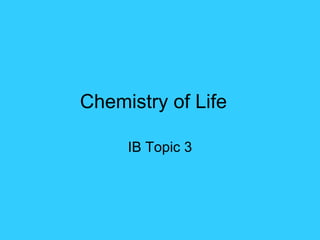Biochemistry PowerPoint
•Télécharger en tant que PPT, PDF•
32 j'aime•39,795 vues
Signaler
Partager
Signaler
Partager

Recommandé
Recommandé
Contenu connexe
Tendances
Tendances (20)
Biochemistry, Biomolecules and Cell: An Introduction

Biochemistry, Biomolecules and Cell: An Introduction
Chemistry of carbohydrates - General introduction and classification

Chemistry of carbohydrates - General introduction and classification
Biochemistry - Ch1 foundation of Biochem , ch2 water and aqueous solution

Biochemistry - Ch1 foundation of Biochem , ch2 water and aqueous solution
En vedette
En vedette (20)
B.sc. biochemistry sem 1 introduction to biochemistry unit 1 foundation of bi...

B.sc. biochemistry sem 1 introduction to biochemistry unit 1 foundation of bi...
Similaire à Biochemistry PowerPoint
Similaire à Biochemistry PowerPoint (20)
Biology - Chp 2 - The Chemistry Of Life - PowerPoint

Biology - Chp 2 - The Chemistry Of Life - PowerPoint
Plus de BiologyIB
Plus de BiologyIB (10)
Biochemistry PowerPoint
- 1. Chemistry of Life IB Topic 3
- 12. #5. Water: General Info (cont.)
- 21. #7. Cohesive properties of water C. Cohesive properties of water are especially important for plants 1. Capillary action-describes how water is able to move up the xylem 2. Cohesion keeps the water molecules intact 3. Adhesion attaches water to the xylem walls 4. Capillary actions in plants is directly related to transpiration
- 39. Classwork/Homework 1. List three examples of each of the following: -monosaccharides, disaccharides and polysaccharides. 2. Draw one of each type of structure (the ones from your notes-glucose, ribose, amino acid, fatty acid, glycerol). 3. Outline condensation and hydrolysis reactions. To do this, use chemical reactions and annotations.